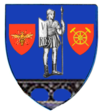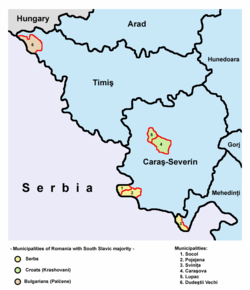- Carașova
-
Carașova
Karašova— Commune — Road in Iabalcea village Location in Caraș-Severin County Location in Romania Coordinates: 45°12′N 21°52′E / 45.2°N 21.867°E Country  Romania
RomaniaCounty Caraş-Severin County Population (2002)[1] – Total 3,260 Time zone EET (UTC+2) – Summer (DST) EEST (UTC+3) Carașova (Romanian: Carașova; Croatian: Karašova or Karaševo; Hungarian: Krassóvár) is a commune in Caraș-Severin County, Romania. It is known especially for its geographical placement and for the origin of its Croatian inhabitants, the Krashovani. The population of the commune numbered 3,260 people at the 2002 census. The commune is composed of three villages: Carașova, Iabalcea (Jabalče; Krassóalmás) and Nermed (Neremić; Nermed).
Contents
Location
Caraşova is located in Caraș-Severin County, in the historical region of Banat, at a distance of 15 kilometers from Reşiţa. It is found in a mountainous area, near the entrance to the Semenic-Cheile Carașului National Park.
Demographics
According to the 2002 census in Romania, the population of Carașova municipality comprises 84.60% Croats, 4.96% others (presumably declared Krashovani), 4.47% Roma, 4.41% Romanians, etc. [1]
Most of the ethnic Krashovani declared themselves as Croats in this census, although in the past they mostly were declaring themselves as Krashovani.
Language
The commune is officially bilingual, with both Romanian and Croatian being used as working languages on public signage and in administration, education and justice.
Religion
Most of the inhabitants of the commune (92.54%) are Roman Catholics.
History
The first time attested in 1333 under the name of Karasow. Other similar names were later used, depending on which administration used them (Nog Carassou and Kyskarassou - 1358, led by the knyaz Bozorad, Krassowcz - 1535, Crassowcz - 1550, Crasso - 1597, Karasevo - 1690-1700, Karasova - 1717, etc.).
Due to the citadel built nearby, Carașova was in the past an important administrative, political and religious centre. In 1333, Carașova was the headquarters of a Roman Catholic diocese which appears to have existed since 1285, but ceased to exist after the events of 1537, and was restored only in 1860, to be disbanded again in 1913.
In various documents of early 18th century, such as the census of 1690-1700 and the conscription of 1717, Carașova was mentioned as having 400 houses, being one of the largest settlements in the area between the Tisa, Mureș and the Danube, being surpassed only by Timişoara and Caransebeş.
In the mid-18th century, according to the administrative organization prior to the Military Frontier of 1768, Caraşova was part of the Vršac county and it was the capital of the administrative circle with the same name which included 32 towns, including Reşiţa, Dognecea, Bocşa, and here were located an administrative office, an Eastern Orthodox church, and Roman Catholic church.
Krashovani
Main article: KrashovaniMost of the people of Caraşova are Krashovani, which are named by the Banat Romanians cârşoveni, caraşoveni, cotcoreţi and cocoşi, while the Croats call themselves Krašovani, Karašovani, Karaševci.
Until 1989, most of the people called themselves caraşoveni and their language caraşoveană and considered themselves a people distinct to the other Slavic peoples around the area, such as Serbian, Croatian or Bulgarian.
After 1989, due to some political, economic, social and cultural factors, the vast majority started identifying themselves as Croats, while a few still continued to call themselves Krašovani. Today, many Krashovani chose the Croatian ethnicity, partly due to the attention given to them by the Croatian state (which also awards them the Croatian citizenship).
References
- ^ (Romanian) "Caraşova", at the Erdélyi Magyar Adatbank's Recensământ 2002; retrieved August 21, 2009
External links
Coordinates: 45°12′N 21°52′E / 45.2°N 21.867°E
Caraş-Severin County, Romania Cities Reşiţa (county seat) · Caransebeş

Towns Anina · Băile Herculane · Bocşa · Moldova Nouă · Oraviţa · Oţelu Roşu
Communes Armeniş · Bănia · Băuţar · Berlişte · Berzasca · Berzovia · Bolvaşniţa · Bozovici · Brebu · Brebu Nou · Buchin · Bucoşniţa · Caraşova · Cărbunari · Ciclova Română · Ciuchici · Ciudanoviţa · Constantin Daicoviciu · Copăcele · Cornea · Cornereva · Coronini · Dalboşeţ · Doclin · Dognecea · Domaşnea · Eftimie Murgu · Ezeriş · Fârliug · Forotic · Gârnic · Glimboca · Goruia · Grădinari · Iablaniţa · Lăpuşnicel · Lăpuşnicu Mare · Luncaviţa · Lupac · Marga · Măureni · Mehadia · Mehadica · Naidăş · Obreja · Ocna de Fier · Păltiniş · Pojejena · Prigor · Răcăşdia · Ramna · Rusca Montană · Sacu · Sasca Montană · Sicheviţa · Slatina-Timiş · Socol · Şopotu Nou · Târnova · Teregova · Ticvaniu Mare · Topleţ · Turnu Ruieni · Văliug · Vărădia · Vermeş · Vrani · Zăvoi · Zorlenţu Mare
Categories:- Communes in Caraş-Severin County
Wikimedia Foundation. 2010.




